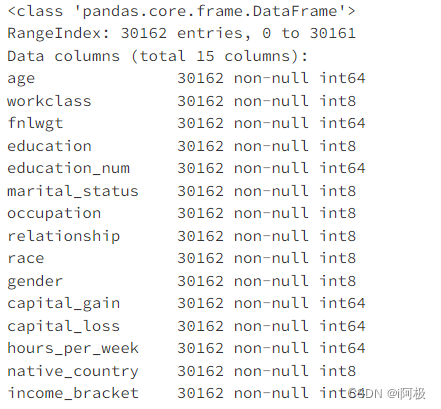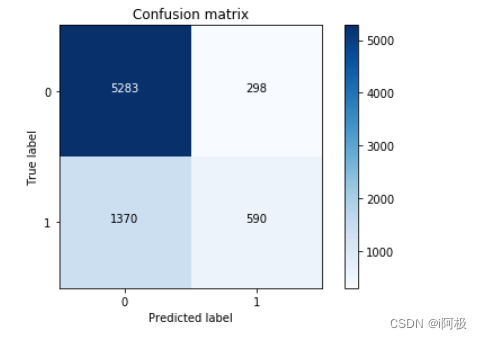
- 机器学习:基于逻辑回归和高斯贝叶斯对人口普查数据集的分类与预测
作者:i阿极
作者简介:Python领域新星作者、多项比赛获奖者:博主个人首页
😊😊😊如果觉得文章不错或能帮助到你学习,可以点赞👍收藏📁评论📒+关注哦!👍👍👍
📜📜📜如果有小伙伴需要数据集和学习交流,文章下方有交流学习区!一起学习进步!💪
文章目录
1、数据说明
| 属性 | 数据类型 | 数值类型 | 字段描述 |
|---|---|---|---|
| 1 | ID | - | String |
| 2 | age | Numeric | Integer |
| 3 | workclass | Categorical | String |
| 4 | fnlwgt | Continuous | Integer |
| 5 | education | Categorical | String |
| 6 | education_num | Numeric | Integer |
| 7 | marital_status | Categorical | String |
| 8 | occupation | Categorical | String |
| 9 | relationship | Categorical | String |
| 10 | race | Categorical | String |
| 11 | gender | Categorical | String |
| 12 | capital_gain | Numeric | Integer |
| 13 | capital_loss | Numeric | Integer |
| 14 | hours_per_week | Numeric | Integer |
| 15 | native_country | Categorical | String |
| 16 | income_bracket | Categorical | Integer |
2、数据探索
导入模块
from plotly import __version__
import plotly.offline as offline
from plotly.offline import init_notebook_mode, iplot
init_notebook_mode(connected=True)
from plotly.graph_objs import *
import colorlover as cl
from plotly import tools
import pandas as pd
import numpy as np
colors = ['#e43620', '#f16d30','#d99a6c','#fed976', '#b3cb95', '#41bfb3','#229bac',
'#256894', '#fed936', '#f36d30', '#b3cb25', '#f14d30','#49bfb5','#252bac',]
导入数据
data_train = pd.read_csv(r'/home/mw/income_census_train.csv')
data_test = pd.read_csv(r'/home/mw/income_census_test.csv')
数据集实例数与特征数,缺失值查看
print('原训练集shape:',data_train.shape)
print('原测试集shape:',data_test.shape)
print('原数据集实例数:',data_train.shape[0]+data_test.shape[0])

print('缺失值检测\n原训练集:',data_train.isnull().values.sum(), ',原测试集:',data_test.isnull().values.sum())

print('所有字段名:',data_train.columns)

各个特征的描述与相关总结
data_train.describe()

展示所有类型特征
data_train.describe(include=['O'])

查看8个categorial数据类型的属性唯一值
print('workclass: ',len(data_train['workclass'].unique()),'个\n',data_train['workclass'].unique())
print('education: ',len(data_train['education'].unique()),'个\n',data_train['education'].unique())
print('marital_status: ',len(data_train['marital_status'].unique()),'个\n',data_train['marital_status'].unique())
print('occupation: ',len(data_train['occupation'].unique()),'个\n',data_train['occupation'].unique())
print('relationship: ',len(data_train['relationship'].unique()),'个\n',data_train['relationship'].unique())
print('race: ',len(data_train['race'].unique()),'个\n',data_train['race'].unique())
print('gender: ',len(data_train['gender'].unique()),'个\n',data_train['gender'].unique())
print('native_country: ',len(data_train['native_country'].unique()),'个\n',data_train['native_country'].unique())

data = data_train.drop(['ID'],axis = 1)
data.head()

3、数据预处理
将oject数据转化为int类型
for feature in data.columns:
if data[feature].dtype == 'object':
data[feature] = pd.Categorical(data[feature]).codes # codes 这个分类的分类代码
data.head()

此时在查看数据每个字段的数值类型都是int类型。
data.info()

4、建立模型
选取特征数据与类别数据
from sklearn.preprocessing import StandardScaler
from sklearn.linear_model import LogisticRegression
from sklearn.model_selection import train_test_split
X_df = data.iloc[:,data.columns != 'income_bracket']
y_df = data.iloc[:,data.columns == 'income_bracket']
X = np.array(X_df)
y = np.array(y_df)
标准化数据
scaler = StandardScaler()
X = scaler.fit_transform(X)
5、特征选取(Feature Selection)
from sklearn.tree import DecisionTreeClassifier
# from sklearn.decomposition import PCA
# fit an Extra Tree model to the data
tree = DecisionTreeClassifier(random_state=0)
tree.fit(X, y)
# 显示每个属性的相对重要性得分
relval = tree.feature_importances_
trace = Bar(x = X_df.columns.tolist(), y = relval, text = [round(i,2) for i in relval], textposition= "outside", marker = dict(color = colors))
iplot(Figure(data = [trace], layout = Layout(title="特征重要性", width = 800, height = 400, yaxis = dict(range = [0,0.25]))))
from sklearn.feature_selection import RFE
# 使用决策树作为模型
lr = DecisionTreeClassifier()
names = X_df.columns.tolist()
# 将所有特征排序
selector = RFE(lr, n_features_to_select = 10)
selector.fit(X,y.ravel())
print("排序后的特征:",sorted(zip(map(lambda x:round(x,4), selector.ranking_), names)))
# 得到新的dataframe
X_df_new = X_df.iloc[:, selector.get_support(indices = False)]
X_df_new.columns
X_new = scaler.fit_transform(np.array(X_df_new)) # 数组化 + 标准化
X_train, X_test, y_train, y_test = train_test_split(X_new,y) # 切分
from sklearn.linear_model import LogisticRegression
from sklearn.naive_bayes import GaussianNB
from sklearn import metrics
from sklearn.metrics import confusion_matrix,roc_curve, auc, recall_score, classification_report
import matplotlib.pyplot as plt
import itertools
# 绘制混淆矩阵
def plot_confusion_matrix(cm, classes,
title='Confusion matrix',
cmap=plt.cm.Blues):
"""
This function prints and plots the confusion matrix.
Normalization can be applied by setting `normalize=True`.
"""
plt.imshow(cm, interpolation='nearest', cmap=cmap)
plt.title(title)
plt.colorbar()
tick_marks = np.arange(len(classes))
plt.xticks(tick_marks, classes, rotation=0)
plt.yticks(tick_marks, classes)
thresh = cm.max() / 2.
for i, j in itertools.product(range(cm.shape[0]), range(cm.shape[1])):
plt.text(j, i, cm[i, j],
horizontalalignment="center",
color="white" if cm[i, j] > thresh else "black")
plt.tight_layout()
plt.ylabel('True label')
plt.xlabel('Predicted label')
6、逻辑回归(Logistic Regression)
# instance
lr = LogisticRegression()
# fit
lr_clf = lr.fit(X_train,y_train.ravel())
# predict
y_pred = lr_clf.predict(X_test)
print('LogisticRegression %s' % metrics.accuracy_score(y_test, y_pred))

cm = confusion_matrix(y_test, y_pred)
class_names = [0,1]
plt.figure()
plot_confusion_matrix(cm , classes=class_names, title='Confusion matrix')
plt.show()

7、高斯贝叶斯(Gaussian Naive Bayes)
gnb = GaussianNB()
gnb_clf = gnb.fit(X_train, y_train.ravel())
y_pred2 = gnb_clf.predict(X_test)
print('GaussianNB %s' % metrics.accuracy_score(y_test, y_pred2))

cm = confusion_matrix(y_test, y_pred2)
class_names = [0,1]
plt.figure()
plot_confusion_matrix(cm , classes=class_names, title='Confusion matrix')
plt.show()

📢文章下方有交流学习区!一起学习进步!💪💪💪
📢首发CSDN博客,创作不易,如果觉得文章不错,可以点赞👍收藏📁评论📒
📢你的支持和鼓励是我创作的动力❗❗❗

























 478
478











 被折叠的 条评论
为什么被折叠?
被折叠的 条评论
为什么被折叠?










